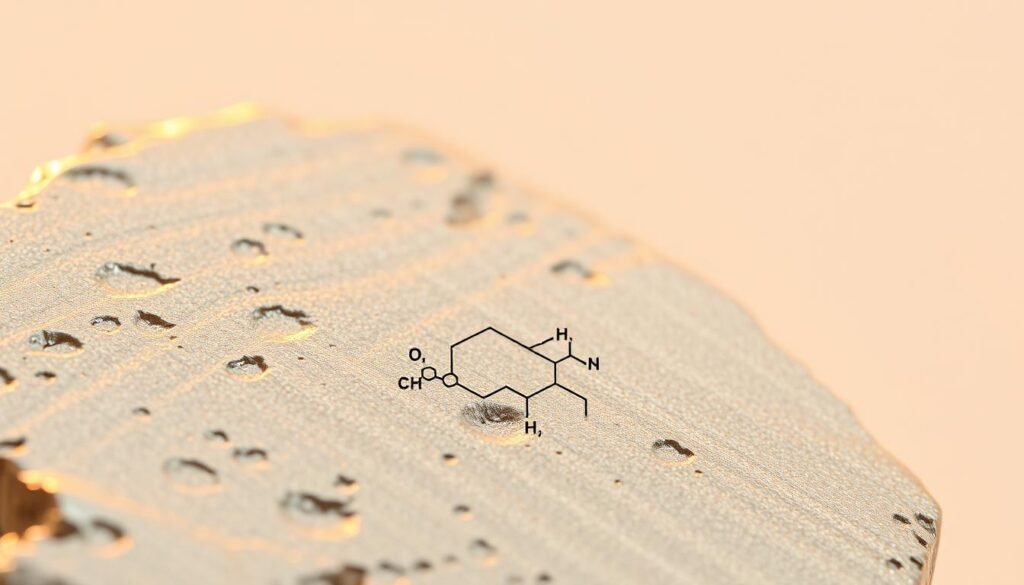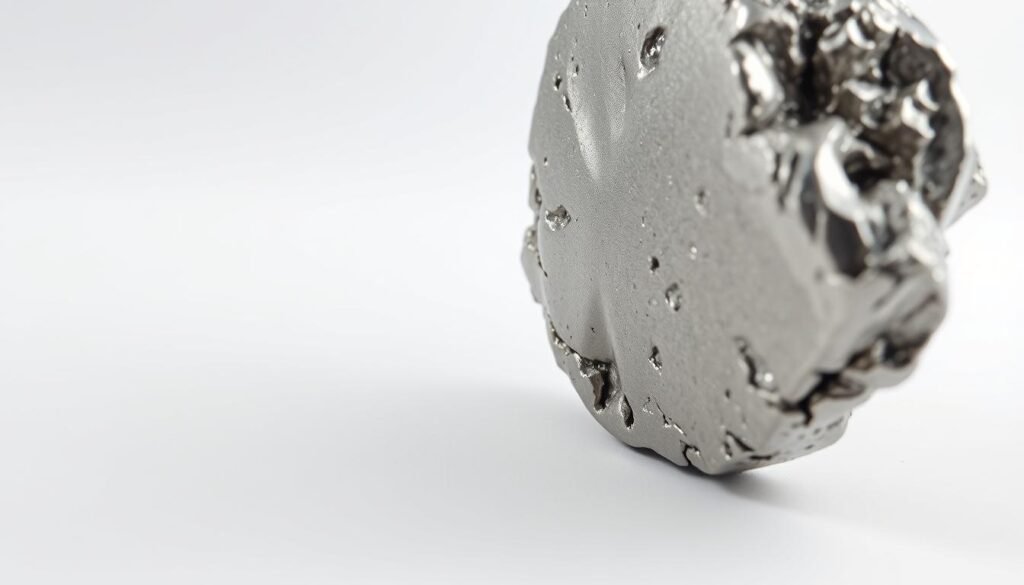Nickel, with the symbol Ni and atomic number 28, is a transition metal known for its shiny appearance. It often looks like gold. Knowing its density, about 8.907 g/cm³ at 20°C, is key for many uses in metallurgy and materials science.
This article will cover nickel’s properties. We’ll look at its history, important uses, and how it affects the environment. We’ll also talk about nickel isotopes and their role in science.
Introduction to Nickel
Nickel is key in metallurgy and manufacturing. It’s known for its corrosion resistance and malleability. These traits make it perfect for many uses, like making stainless steel. About 68% of the world’s nickel goes into stainless steel.
Humans have used nickel for thousands of years. Ancient civilizations made tools from meteorite metal. But it wasn’t until the mid-18th century that scientists identified nickel as a separate element.
The nickel introduction to modern industries showed its value. It’s used in batteries, alloys, and electrical parts. Its strength and ability to resist wear and tarnish are key. These qualities help advance technology and build better structures.
Properties of Nickel
Nickel has many important chemical and physical properties. These help it be used in many ways across different industries. Knowing about these properties shows why nickel is key in making things and in technology. We’ll look at the chemical and physical properties of nickel that are important for its uses.
Chemical Properties
Nickel can be in several oxidation states, like +2, +3, and +4. But +2 is the most common in its compounds. This makes nickel useful in many chemical reactions, creating important compounds like nickel sulfate and nickel chloride. These are key in electrochemistry.
What really stands out about nickel is its ability to be ferromagnetic at room temperature. This makes it great for use in electronics and magnets.
Physical Properties
Nickel has a high melting point of 1455°C. This is why it works well in high-temperature situations. It also has great thermal and electrical conductivity. Plus, its density is important for batteries and catalysts.
Here’s a table showing some of nickel’s physical properties:
| Property | Value |
|---|---|
| Melting Point | 1455°C |
| Density | 8.91 g/cm³ |
| Electrical Conductivity | 106% IACS |
| Thermal Conductivity | 90 W/m·K |

Understanding Density
Density tells us how much mass is packed into a given volume of a substance. Knowing the definition of density is key to understanding materials, like metals. It helps decide if a metal is right for a job.
Definition of Density
The definition of density is simple: mass divided by volume. For metals, density is important for their weight and how well they perform. Metals vary in density, affecting their strength and flexibility.
Importance of Density in Metals
When working with metals, density matters a lot. Heavy metals like gold and lead are strong and good for building. But, light metals like aluminum and titanium are better for things that need to be light, like planes.
| Metal | Density (kg/m³) |
|---|---|
| Nickel | 8,908 |
| Aluminum | 2,700 |
| Brass | 8,530 |
| Bronze | 8,150 |
| Gold | 19,300 |
| Copper | 8,920 |
| Tungsten | 19,600 |
Density of Nickel
The density of nickel is key in many uses, affecting its strength and fit in various fields. Knowing the nickel density value helps us understand how it acts in different settings.
Specific Density Value
The nickel density value is about 8.907 g/cm³ at 20°C. This number is a key reference for its properties in industry and science.
Factors Affecting Nickel’s Density
Several things can change the nickel density value. These include:
- Temperature: Changes in temperature can alter nickel’s atomic spacing, affecting its density.
- Pressure: More pressure can compress nickel’s atoms, changing its density.
- Presence of Impurities: Impurities in nickel can mess with its crystal structure, affecting its density.
- Crystalline Structure: Nickel’s atom arrangement can change based on its phase, impacting its density.
These factors are important for those working with nickel, where performance under stress matters a lot.

Historical Context of Nickel
The history of nickel goes back to the early 18th century. In 1751, Axel Fredrik Cronstedt first identified it. He found it in ‘kupfernickel’, or ‘copper nickel.’
This discovery was a big deal because nickel was often mistaken for copper. Miners had to work hard to separate them.
Nickel has been used for thousands of years. It was first used around 3500 BCE. Ancient people valued it for its strength and beauty.
In the 19th century, nickel became even more important. It was used to make stronger steel. This change helped many industries grow and improve.
| Year | Event |
|---|---|
| 1751 | Identification of nickel as a distinct element by Axel Fredrik Cronstedt. |
| 3500 BCE | Evidence of nickel artifacts indicates early use of the metal. |
| 19th Century | Widespread industrial use of nickel and its alloys begins with steel manufacturing. |
Industrial Applications of Nickel
Nickel is used in many ways across different industries. It’s important in making things and in our daily lives. Its special qualities lead to new uses that make things work better and last longer.
Use in Alloys
Nickel alloys are key in engineering and building. They are strong, don’t rust easily, and can handle very high or low temperatures. Inconel and Monel are examples used in planes, chemical plants, and at sea.
These alloys help make parts last longer in tough conditions.
Nickel in Everyday Objects
Nickel is also in many things we use every day. Stainless steel pots and pans have nickel to prevent rust and stains. It’s also in batteries for gadgets, keeping them charged.

| Application Type | Example Materials | Industry |
|---|---|---|
| Alloys | Inconel, Monel | Aerospace, Marine |
| Cookware | Stainless Steel | Consumer Goods |
| Batteries | NiCd, NiMH | Electronics |
| Coins | N/A | Finance |
Nickel’s ability to be used in many ways shows its value. It’s important in both special and everyday items.
Health and Environmental Aspects
Nickel can have big health problems for people who are exposed to it. It often causes skin allergies and breathing issues. Long-term exposure might even lead to cancer, which is a big worry for workers in nickel-using industries.
The environmental damage from nickel is also a big concern. Nickel mining can harm local ecosystems, threatening plants and animals. It can also pollute soil and water, affecting both nature and nearby communities.
To lessen these risks, we need to use better mining and processing methods. We should also make and enforce stricter rules. This will help reduce the harm caused by nickel production.
Occurrence of Nickel in Nature
Nickel is not very common in the Earth’s crust but is very important. It comes from two main types of ores: sulfide and lateritic. Knowing where nickel comes from helps us understand how it’s used.
Sources of Nickel Ores
Nickel ores come from different places:
- Sulfide Ores: These ores have a lot of nickel and include minerals like pentlandite and chalcopyrite. They are found in high-grade deposits.
- Lateritic Ores: These ores form when rocks weather and have less nickel. They are found in warm, wet places.
Places around the world have nickel deposits that are worth mining. Sudbury in Canada is famous for its sulfide deposits. New Caledonia is known for its lateritic ores. These places are key in the global nickel trade.
Distribution in Earth’s Crust
Nickel makes up about 0.008% of the Earth’s crust. But, it’s thought to be more common in the Earth’s core. This makes nickel very important in the Earth’s structure.
| Type of Nickel Ore | Characteristics | Geographic Locations |
|---|---|---|
| Sulfide Ores | High grade, suitable for smelting | Sudbury, Canada |
| Lateritic Ores | Lower grade, extracted via hydrometallurgical methods | New Caledonia, Indonesia |
Learning about nickel’s occurrence and distribution helps us see its importance. It shows how nickel is vital for industries and the global economy.
Isotopes of Nickel
Nickel has five stable isotopes, each with its own role. Nickel-58 is the most common, making up about 68.1% of natural nickel. Studying nickel isotopes is key in fields like geology and nuclear science.
These isotopes show how nickel forms and changes over time. They help us understand geological processes and nuclear reactions.
Other stable isotopes of nickel include Nickel-60, Nickel-61, Nickel-62, and Nickel-64. Each has unique nuclear properties.
By studying these isotopes, scientists can track nickel’s origins in nature. They also learn about the history of nickel formation. This info is useful for dating metals and understanding their age.
Technological Advances in Nickel Processing
Nickel processing has seen big changes over the years. The Mond process, from the early 1900s, uses nickel carbonyl to purify nickel. This shows how efficient nickel extraction can be, key to the process.
New methods in nickel extraction aim to reduce harm to the environment. Hydrometallurgical techniques, for example, use less energy and produce less waste than old methods. These advancements make nickel production more efficient and eco-friendly.
Nickel’s importance in tech fields like electronics and aerospace is growing. These fields need materials that can handle tough conditions. So, there’s a push to improve nickel processing to meet these needs.
Conclusion
Nickel is known for its amazing properties, like a density of about 8.907 grams per cubic centimeter. Its resistance to corrosion and ability to handle extreme temperatures make it essential. It’s used in stainless steel and electronics.
As industries grow, nickel’s uses will expand, too. This is true for new areas like renewable energy. Nickel’s role in battery making and aerospace shows its key part in innovation and green tech.
Research and new tech are making nickel even more useful. Its importance in battery and aerospace fields is clear. With better metal processing and new alloys, nickel will keep being valuable.
For those curious about nickel’s technical side, a summary of nickel density is available. As we move forward, nickel’s special abilities will be key in many fields. It will remain a vital resource for the future.
